And others that stay out for extended periods like
@Road. How much/many clothes rotations do you usually plan for and how do you deal with washing? What's the best way to wash remotely? Need ya'll's ideas and experience on this. TIA.
.
Great question; I love topics on extended adventures, especially when about trips lasting several months. So I'm gonna fill up a post for ya, with what's worked for me over the years. It usually acts a first draft for future articles or blog posts.
I
still pack more wardrobe than I need or always use, mostly because I know I may be out long enough to experience drastically different environments before I ever get back to a home-base anywhere. For a few years, because so many family elders were close to dying, I even kept a dark suit in the van for flying somewhere on short notice.
I also tend to pack backup clothes in case the stuff I wear daily gets ruined, goes missing, or wears out; all of which has happened on long adventures. TIP:
Don't wear your favorite adventure shirt when crawling under your vehicle for maintenance.

Now I try to keep all daily clothing other than outerwear limited to what I can pack easily in my
Big Haul 60 duffle. I like to use
Kit Kubes too (famous with motorcycle adventurers), to help organize and make it easier to grab just what I need without pulling everything out into a mess. Kit Kubes are also handy for storing other things like cables and batteries, etc. Overland Adventurer Designs, who made these, has recently changed hands so these Kubes are not always easy to find. They've lasted me years without trouble.
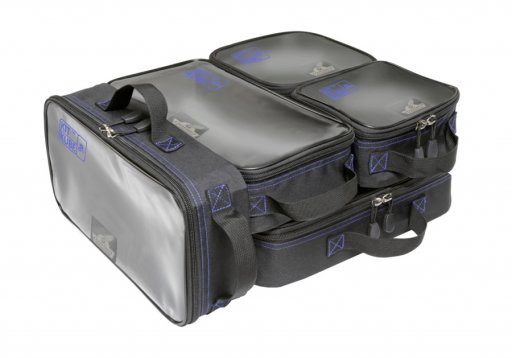
My wardrobe has evolved to primarily multi-purpose pants, shirts, and jackets. Clothes that work well for trail and driving all day, for example, that also look good going out to dinner that night somewhere nice without changing. Clothes that layer well, too, so the same shirt or pair of pants that are comfortable in desert heat can be easily used with a base layer when in the mountains.
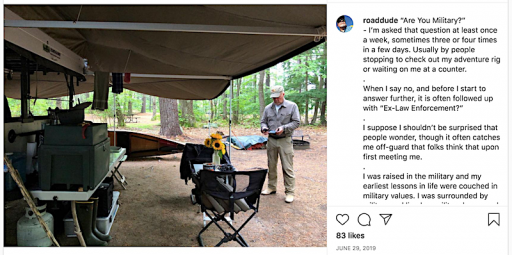
(click the pic for the whole story on insta)
Sometimes all I wear for days is jeans & boots, t-shirt, and a hoody. Other times I'm dressed more for camp work and adventure and carry more gear in my pockets.
Amount of clothes: When working on the road steady for years without house or apartment, often packing minimally for airports, I kept a three garment rule like many travelers do;
1 to wear, 1 clean & ready, 1 in laundry.
This works for everything from work clothes to casual wear to underwear. I still use this for packing get-home bags or overnight bags for canoe or bike. Though for the main vehicle I still pack more; especially things that get changed more often like socks and underwear.
As you've noted, choice of fabrics and ease of washing becomes important. Other than jeans--which I usually take three pairs of and tend to wear for a week unless really filthy/sweaty--I try to buy only well-made, easy to care for, lightweight-but-rugged clothing. Sometimes more expensive at the start, though last far longer and still look better after years than having to buy more often. Less expensive in the long run.
PANTS:
- I don't like and quit wearing the convertible shorts/pants that zip off at the knee. In fact, I don't often wear shorts at all when camping or back country.
- I've leaned heavily towards Helikon-Tex pants for years as best all-around and easiest to care for adventure pants. I have both their
Outdoor Tactical and
Urban Tactical pants, though like the Outdoor Tactical pants (in image above) a bit better. The two lines are made of different fabric; polycotton ripstop for the Urban and VersaStretch for the Outdoor.
Like so many outdoor products, they've gone up in price because the pandemic upset supply chains and labor forces, and anything outdoor recreation related is seeing historic interest.
These pants are SO well thought out and very well made, with reinforced pocket edges where I'm likely to clip lights and knives, inner sleeves to help keep pocket contents organized, and several other smartly designed features, all in a cool breathable fabric. Very comfortable for all day/all night use, they're meant more for shooting (and even have sleeves for knee pads), though work perfectly for my style of adventuring.
I'm going to do a blog post on just these pants sometime, I like them so much.
Here's their promo vid outlining the Outdoor Tactical features:
.
I also have some very lightweight Exofficio
Vent'r pants, which have a vent up each inner leg:
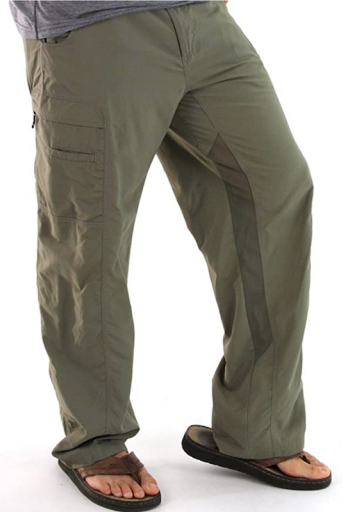
Huge benefit when desert hiking or in wicked humid environs like the swamp, though the pair I have need to be re-hemmed. They are nowhere near as functional in storage as the Helikon-Tex.
SHIRTS:
I've used primarily ExOfficio t-shirts and button ups, both long and short-sleeved. Though, like too many other products I favor, they quit making the t-shirt line I liked the most, the
Exo-Dri, and I've been casting about for a replacement. They are lightweight, breathe well, are made just right, necks don't stretch over time, are "Odor Resistant Dri-Release" and last just about forever; I am still wearing some I bought in 2010. I've messed up too many of them with paint and grease, etc.
I really like the ExOfficio
Minimo button shirts, though have some of their Sol Cool and Halstett shirts (in camp image above) as well. The Minimo shirts are perfect for intense desert days or layering in cooler weather, in that they are
so lightweight, moisture-wicking, vented across the back with an inner mesh, and can be worn long sleeved in the heat.
There's a reason you always see landscapers wearing long sleeve buttoned up shirts when working in the sun, and these shirts are perfect for that. It's like wearing a well vented tent with a constant breeze. Keeps your skin cooler and you more comfortable than if wearing a short-sleeved t-shirt. Ever feel the heat that radiates from someone who's worn short sleeves or a tank-top all day?
Also really nice were the
North Face Syncline shirts; amazing fabric, very long-lasting, good looking and come out of the wash or a duffle looking great. Also no longer available except in extreme sizes, if at all.
Underwear I like is also from
ExOfficio; the most comfortable for any activity and easiest to care for I've ever worn. They last a very long time. Socks I typically go for over-the-calf because I were a lot of tall western boots.
** A lot of the ExOfficio clothing has either BugsAway and/or anti-microbial treatment, greatly expanding their usefulness for adventuring. I've been around others when camping who are getting bothered by bugs when I'm not, and often forget my clothing and choice of soap makes a difference.
One of my all-around favorite shirts is a simple long-sleeved cotton Dickies button-down work shirt. Had it for years, worn it all over America, beat the hell out of it, and I'd still wear it out to dinner. It's in the image below with the Akubra hat.
HATS:
Don't forget hats when planning for an extended adventure. Though I wear a ball cap a lot, I have a few wide-brimmed hats for sun and rain.
Out alone in the willy-wacks, I've learned I don't like wearing hoods on jackets or sweatshirts, as I can't hear what's going on around me as well as I can with a hat. The brim on a good hat actually reflects the sound to your ear, if you think about it. Go out and sit in desert darkness alone and try it.
One of my favorites for intense sun and heat is my
SunBody Palm River Cattleman...4" brim, inexpensive and light, easy to soak and shape, and easy to give a good soaking before going out walking. Like wearing an AC on your head when it's had a good soak. Looks goofy to others when east of the Pecos, for but southwestern deserts it's perfect.
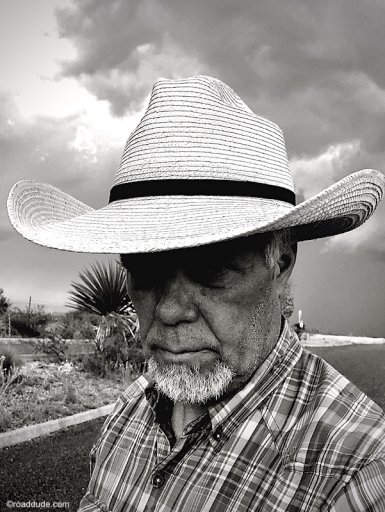 Sunbody Palm River Cattleman's Hat
Sunbody Palm River Cattleman's Hat and
ExOfficio Minimo shirt.
I walked into a remote small town hardware store out west to buy a long-handled shovel, wearing this hat and a clean sparkling white long-sleeved t-shirt. I walked up to the register holding the shovel round point up. The owner looked up from behind the counter, grinned, and said "You look like a lost Amish farmer!"
"Kind of an American Desert Gothic look with this shovel," I admitted.
I love my Akubra hats, too. Great, rugged, Australian-made, very comfortable and long-lasting. Wear a good hat like the one below and raingear with a stand-up collar, and you can work in a storm quite comfortably without rain running down your back. Better than hooded rain gear any day.
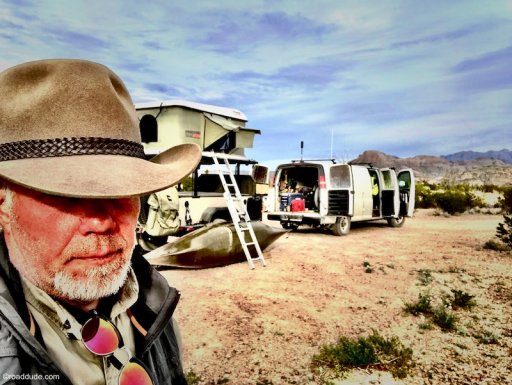
Akubra Snowy River hat, Dickies work shirt, Columbia (I think) vest with ton 'o pockets.
amzn used to carry several Akubra, though don't now. Here's a list, though, of
Akubra Dealers in North America
Washing Clothes On the Road & Dealing With Grey Water:
All of the above clothes are easy to wash on the road. I like the
Sea to Summit Wilderness Wash, too, and keep the larger size of it and their
Citronella Wilderness Wash to refill smaller bottles of it for various packs. I like the Citronella Wash for both body and clothing if bugs are out. Smells nice, not overly strong, and does make a difference in being less appealing to bugs, if only for a day or two.
Dawn dish soap does well in camp, too, though a little dab'll do ya. Cuts grease like a pro. It's why it's often used to clean shore birds caught in oil pills. No idea, though, how good or bad it might be for the environment.
*** Be aware that even though a soap says
biodegradable, it's still not great to throw the waste water just anywhere. It can still affect the balance in streams, rivers, and ponds.
I use as little water and soap as possible, starting with the cleanest of my dirty clothes and working to the dirtiest in my wash water. I keep a
mini-plastic washboard for washing clothes in camp. Wring every bit of soap you can out of just-scrubbed clothes back into the tub and start a pile. When you've got it all washed, do the same with fresh rinse water. Washing and rinsing each piece before doing another often fouls your rinse water more.
With both dishes and laundry, I consider it a challenge to see how clean I can keep my waste water. I rarely heat water for washing anything, though using my on-demand propane water heater for the occasional shower or washing dishes when it's cold out can be nice.
An interesting fact about using water from ponds, lakes, and streams/rivers to wash things is that if you're worried about
Giardia, letting your dishes and clothes dry completely before using, kills it. So, you do not always have to use your
stored fresh water for washing dishes and clothing.
In places that don't forbid getting rid of grey water, I'll often dig a small sump pit way away from streams (100 paces is a good measure) and line it with stones, gravel, and sand, from bottom up, and dump my gray water there, especially when base camping for a bit. In places that state in their literature or signage that they discourage dumping grey water on plants etc, I'll add it to a 5gal jerry and dump it next time I pass a bathhouse, suitable outhouse, or RV dump.
Sometimes I spread my rinse water around camp on various plants. This is a Leatherstem plant at the edge of a camp where I stayed several weeks, that thrived and bloomed before others from regular doses of my rinse water.
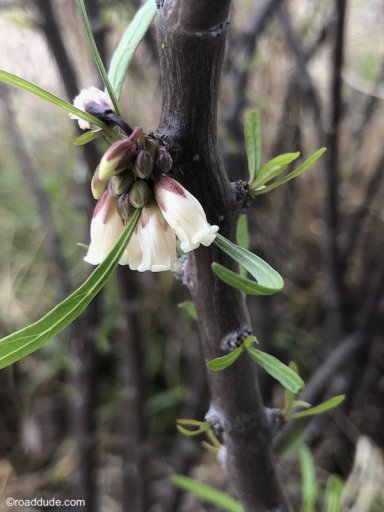
Leatherstem Blossom - the tiny bells on these blossoms are only .025" wide. Also called Sangro de Drago (Devil's Blood) as it's yellow sap turns deep red when exposed to air. It was/is often used by Native Americans as a toothbrush by chewing the stem and using the frayed end, and as treatment for sore gums.
Here's more about grey water:
Grey Water Etiquette - To Dump or to Hold
I wash my clothes and bedding quite often while in camp. Having a sink and counter on my trailer helps, though I'll use just the tub from the sink, too, on the tailgate, inside the back doors to my van, or just on the ground. It's just an inexpensive 12"x14"x6" plastic dishpan, 2.5-3 gal I think, typically available at the grocery for a few bucks. I get a new one every year or so for my camp kitchen, and use the older one for other camp chores. Easy to store and nest together, too:
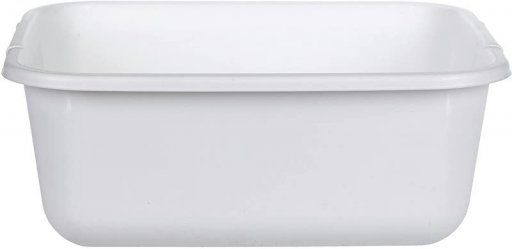
I usually wash and rinse in one of these, then hang everything to dry. I've used a 5gal bucket too, sometimes just for rinse after using the tub for washing. Some days my trailer looks like a refugee camp with clothes drying all over the place.
If staying at a motel on the odd night, I'll take the opportunity to wash clothes then as well, just using the bathroom sink. A lot of outdoor rec areas like national parks have commercial facilities in nearby towns that provide both shower and laundry, or I'll save things like dirty jeans and heavier items for runs into town and just make it a market & laundry afternoon and grab a good meal somewhere, chat up the locals, then head back to camp.
If needing just-washed items quicker, or just doing socks/underwear for example, whether in camp or motel; rinse and wring them out well, then roll them up tight in a clean towel and walk on it. Stomping, I've seen it called. That'll draw out most of the moisture and they will air dry
much quicker. The clothes I've outlined above all dry quite fast that way.
Some of this is outlined in an older blog post of mine,
Staying Clean On the Road, which needs updating on both products I prefer and adding wash methods, etc.
Perhaps this post will get me closer to doing that

.
.













